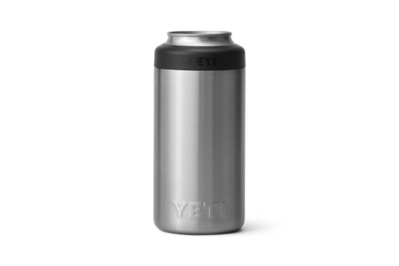Staff pick
You needn’t be a die-hard beer connoisseur to know that warm beer sucks. Unfortunately, many craft beers are sold in 16-ounce tallboys these days rather than standard 12-ounce cans, which means that once you pop the top, chances are greater that your beer will turn tepid before you reach the bottom.
In addition, craft beers often boast a higher alcohol content than mass-produced beers, which is just one reason they tend to be more expensive. So you may want to drink them more slowly to avoid getting too tipsy too fast.
The Yeti Colster, boasting the same stainless steel, double-walled insulation as our top-pick insulated wine tumbler, the Yeti Rambler, impressively safeguards against those concerns. All you need to do is unscrew the Colster’s gasket-style top, slide your cold can of beer in, and screw it back on.
The top of the can is unencumbered by the screw top, so sipping feels exactly the same. The Colster’s exterior, meanwhile, doesn’t get uncomfortably cold or sweaty like an uninsulated can often does. (You can pre-chill your Colster if you want, but I find it’s unnecessary.)
According to the American Homebrewers Association, all beers should be served at temperatures from 38 to 55 degrees Fahrenheit. In the experiments I conducted to test the Yeti Colster’s effectiveness, I found that an uninsulated can of beer, once taken out of the refrigerator, exceeds that ideal temperature anywhere from three to five times faster than a can in a Colster—which is much faster than I care to drink it.

When left to sit untouched near a sunny window in a 73 °F room, an uninsulated, 16-ounce lager climbed from 46 °F to 55 °F in 33 minutes. In comparison, another can of the same 16-ounce lager housed in a Colster took 2 hours 35 minutes to go from 46 °F to 55 °F.
When I replicated this test outdoors on a cool, fall afternoon with a 16-ounce IPA—this time while actually handling the can and sipping from it periodically—the uninsulated beer turned too warm even faster. Starting at 48 °F, and checking the beers’ temperatures about every 10 minutes in between sips, I found that the uninsulated beer hit 55 °F in about 24 minutes; in less than an hour, it had reached 62 °F. Meanwhile, a Colstered IPA that my husband drank at the same time climbed only 4 degrees over the course of the hour.
I also ran tests with chilled pint glasses and found that they really didn’t help keep my drink cold in the long run. A 16-ounce IPA poured into a chilled pint glass in a 70 °F room climbed from 41 °F to 55 °F in 43 minutes. A 16-ounce Colstered can of the same IPA, also starting at 41 °F, took 2 hours 20 minutes to hit 55 °F.
To be fair, I chilled those pint glasses in my fridge rather than my freezer, even though the latter would have obviously made them even colder. Unfortunately, I didn’t have enough room in my freezer to stash any glasses, which would be a recurring problem for me if I were to rely on chilled glasses rather than Colsters to keep my beers fresh. But that isn’t the only issue I would encounter in such a scenario—you also have to remember to chill glasses ahead of time and replenish them as needed.
Plus, as Eric Asimov, chief wine critic for The New York Times, told me, “When you chill glasses in the freezer, in my experience, there’s some condensation that forms on it that then dissolves into the beer. I’ve never really believed in chilling glasses.”
To me, being able to easily keep your drink at an ideal temperature for longer is both a bit of a money saver (or at least, you don’t feel like you’re throwing away money by tossing the last few sips of every can) and something of a healthy-lifestyle hack—because pacing yourself today is the key to feeling better tomorrow.
“When you’re holding a beer that’s not insulated, I think you probably tend to drink it a little faster,” said my friend Justin. (We got him his first Colster, and he has since ordered several dozen customized ones to give to clients at his job.) “The Yeti allows me to enjoy my beer a little more slowly.”
The Colster also comes in a standard 12-ounce size—which, according to my friend-circle research, is especially nice for nonalcoholic fizzy drinks. If canned seltzer is your hydrating beverage of choice, for example, a Colster offers a convenient way to ensure that yours stays enjoyably bubbly, since warmth makes fizzy drinks go flat.

“I don’t open any ‘near beer’ or sparkling water without putting it in a Yeti,” Justin added. “I actually use my 12-ounce Colster more than my 16-ounce.”
For him, the 12-ounce Colster offers more options to keep himself from overindulging on alcohol.
“When you want one more beer, but you know that’s the difference between a good day and a bad day tomorrow, I’ll switch to near beer,” he explained. “The Yeti makes near beers more fun to drink and makes me forget they’re near beers, because once a near beer gets warm, it’s not pleasant to drink at all; you can taste that it’s near beer.”
All that said, is the Colster also, as Justin put it, nothing more than a “bougie-dad koozie”? Yes, you could easily say so. Is the Colster a prime example of unitask-gadget overkill? Quite possibly. Should you buy the Colster when it goes on sale for $15, which I’ve seen happen on Amazon during deal events like Prime Day or Black Friday? Absolutely.
The way I see it, a durable, simple-to-use device that lets you more thoroughly savor your drink is like splurging a little on freshly ground coffee beans or real maple syrup or good olive oil. It may not be necessary and may run you a few more bucks, but it’s a small improvement you’ll appreciate every time.
And you’ve got to admit, it’s cool—in this case, both figuratively and literally.
This article was edited by Megan Beauchamp and Catherine Kast.





